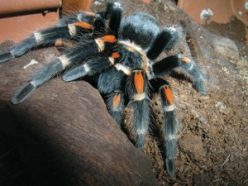Silky spider footprints
Tarantulas use foot-spun silk to hold tight in slippery situations

When one of his foes knocks him down, Spider-Man doesn’t fall far: With a flick of his wrist, he saves himself with a spray of sticky webbing. Like that fictional superhero, tarantulas may have a similar way to keep from falling.
In a new study, scientists found that tarantulas can shoot silk from their feet. This little trick can come in handy, saving giant, hairy spiders from splattering after a long fall. Tarantulas create silk and shoot it from tiny devices in their abdomens called spinnerets. But the recent work suggests silk may be made and used elsewhere on the spider body.
Claire Rind, a biologist at Newcastle University in England, worked on the study. She and her colleagues designed an experiment to find the silky footprints of spiders that were sticking to slippery surfaces. They placed glass slides inside tarantula cages and then tilted them so the spiders were sticking to vertical (upright) surfaces. After turning on a video camera to record the experiment, the researchers gave the cage a little bump to see if the spiders would lose their grip.
Rind and her team watched the video to see where the spider feet slipped a bit. When they studied the slides, they found silky footprints where the spiders had been standing. The finding suggests that the spiders had used a bit of silk to steady themselves after the bump. The scientists didn’t stop there: They also studied zoomed-in images of the spider feet and found tiny, hairlike structures that might shoot silk.
The idea that some spiders hide silk shooters in their feet was proposed in 2006 by scientists working with zebra tarantulas. Those researchers claimed that the tarantulas had silk glands in their feet. The discovery excited spider scientists, Todd Blackledge, a biologist at the University of Akron in Ohio, told Science News. Blackledge and his colleagues study spiders that spin silk to try to understand how these animals acquired such a nifty trick — and how it affects their behavior.
The possibility that spiders could spin silk from their feet “made quite a splash in the arachnological community,” he said. Arachnology is the study of spiders. “It seemed almost too good to be true that [scientists] working on tarantulas hadn’t already described this,” Blackledge said.
The study didn’t stick. In 2009, another team of scientists looked for silky spider footprints on glass and came to a different conclusion. The footprints appeared initially. But when the researchers covered up a spider’s abdominal spinnerets, the footprints did not appear — suggesting that silk came from the abdomen, not the feet. Rind and her colleagues did not cover the abdominal spinnerets. But they say the video allows them to see that the silk came from the exact same place as the spider’s feet.
Spiders can create different types of silks for different occasions. Scientists study these silks and their uses to understand how spiders as a group evolved, or changed over long periods of time, to be able to spin silk.
POWER WORDS (adapted from the New Oxford American Dictionary)
spinneret Any of a number of different organs that produce the silk, gossamer or thread of spiders, silkworms and certain other insects.
tarantula A hairy spider, some of which grow large enough to catch small lizards, frogs and birds.
arachnid A group of invertebrate animals that includes spiders, scorpions, mites and ticks. Many have silk or poison glands.
silk A fine, strong, soft fiber spun by a range of animals, such as silkworms and many other caterpillars, weaver ants, caddis flies and — the real artists — spiders.







